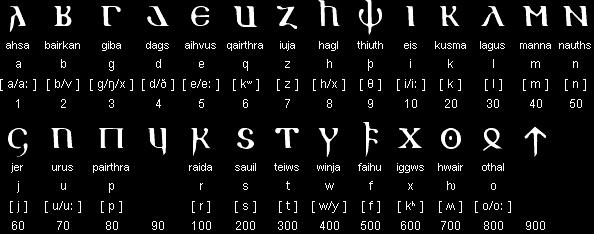|
The Gothic-Alphabet
Although we have no affiliation with the ancient Goths, I thought it would be fun to have their alphabet. The Goths used runes to read and write, but runes were affiliated with their old heathen traditions, and therefore they needed a new alphabet in order to be effectively assimilated into the Christian empire. Despite changing the characters for the Gothic-lettering many of them were relatively unchanged from their Elder Futhark counterparts; and the majority of them kept their runic names. In fact, some of the letters aren't changed at all. Many are slightly distorted. However, I won't go into the Elder Futhark alphabet, since this page is strictly about the Gothic-alphabet. Gothic-LettersThe Gothic-letters list off as such: Ahsa, Bairkan, Giba, Dags, Aihwus, Qairthra, Ezec, Hagl, Thiuth, Eis, Kusma, Lagus, Manna, Nauths, Jer, Urus, Pairtha, Raida, Sauil, Teiws, Winja, Faihu, Iggws, Hwuair, and Othal. The letters would transliterate to English as follows: A, B, G, D, E, Q, Z, H, Th, I, K, L, M, N, J, U, P, R, S, T, W, F, X, Hw, O. It may appear all scrambled up, but like a lot of dead languages each letter has a numeric value. There are two letters that don't have a name, only a number value. Whereas, in English and most modern languages, numbers and letters are kept seperate. To recite the Gothic-Alphabet is also like counting to 900; even though two of the letters are missing. 
|